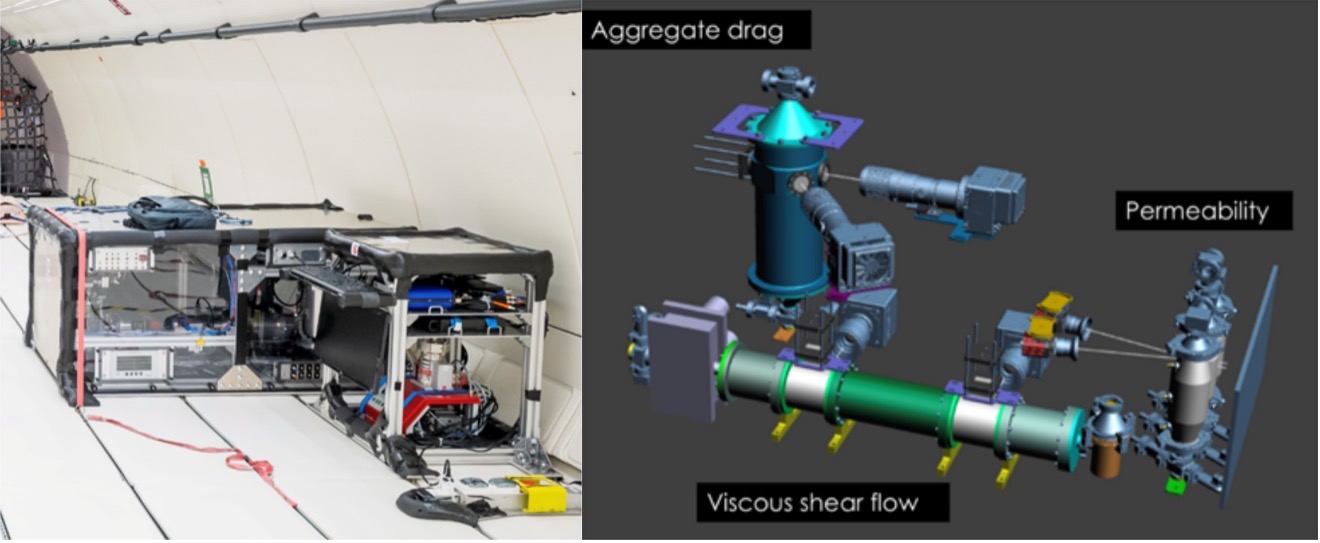Aerodynamic and Mechanical Properties of Dust Aggregates in Low-Gravity Environments
- 1Space Research and Planetary Sciences, Physics institute, University of Bern, Sidlerstrasse 5, CH-3012 Bern, Switzerland (holly.capelo@unibe.ch)
- 2ETH Zurich, Institute of Geochemistry and Petrology, 8092 Zurich, Switzerland
- 3Center for Theoretical Astrophysics and Cosmology, Institute for Computational Science, University of Zurich, Winterthurerstrasse 190, CH-8057 Zurich, Switzerland
Understanding the intricate dynamics of gas-dust interactions within protoplanetary disks is crucial for unraveling the mysteries of planetary system formation. We introduce TEMPus VoLA (Timed Epstien Multi-pressure vessel at Low Accelerations), an experimental setup designed to investigate particle dynamics and rarefied gas behavior in microgravity (Capelo et al. 2022 https://doi.org/10.1063/5.0087030). Figure 1 shows the experimental setup in flight configuration, together with a rendering of the multiple pressure vessels containing low-pressure gas and dust analogue materials.

Figure 1 (Reproduced from Capelo et al 2022). Left: TEMPusVoLA in flight configuration aboard Air Zero-G. Right: Multiple pressure vessels containing rarified gas and dust particle analog. Each chamber is designated to study a particular process: Shear flow, permeability, and drag forces on aggregates.
Through multiple dedicated experiments, we explore the effects of collective particle-gas interaction on pressure gradients (permeability), aerodynamic drag coefficients and mechanical properties of dust aggregates, and the onset of turbulence in shear flows. Figure 2 shows an example of a periodic velocity field developing in the shear flow chamber, where dust is injected as a stream in the flow of gas at vaccum pressure. We interpret the velocity field to indicate the onset of a Kelvin-Helmholtz like instability, generated for the first time with dust as the dense phase in pure molecular flow.
Figure 2 (Reproduced from Capelo et al. 2022). Particle-velocity in the stream-wise direction of the shear flow chamber, derived using particle image velocimetry. The particle velocities are not constant, but rather oscilate.
Our findings, gleaned from multiple parabolic flight campaigns, support a better understanding of dust transport and dynamics in planet-forming discs and also have implications for understanding phenomena like dust emission from cometary nuclei. The presented framework offers a valuable tool for validating models and numerical simulations of collective dust particle aerodynamics in low-gravity environments.
How to cite: Capelo, H. L., Bodénan, J.-D., Jutzi, M., Kühn, J., Mayer, L., Schönbächler, M., Thomas, N., and Pommerol, A.: Aerodynamic and Mechanical Properties of Dust Aggregates in Low-Gravity Environments, Europlanet Science Congress 2024, Berlin, Germany, 8–13 Sep 2024, EPSC2024-899, https://doi.org/10.5194/epsc2024-899, 2024.